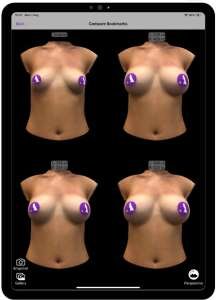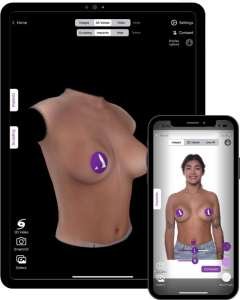Can 3D consultation help you pick the perfect breast implants?
Yes, During a 3D consultation, your breasts are often shown in three dimensions utilising cutting-edge imaging technology. Techniques like 3D scanning or computer-generated modelling can be used for this.
During a 3D consultation, you can work closely with a plastic surgeon to visualize different breast implant options and see how they might look on your body. The surgeon can show you various sizes, shapes, and profiles of breast implants and simulate the potential outcomes of each option. This can give you a better understanding of how different implants might enhance your overall appearance.
By virtually trying on different implants through 3D consultation, like at our centre, where Dr. Anmol Chugh, a Board Certified Plastic Surgeon, uses the most advanced Augmented Reality (AR) 3D simulation for breast implants, you can make more informed decisions about the size and shape of the implants that would best suit your desired aesthetic goals and body proportions. It allows you to preview the potential results before committing to surgery, which can help manage expectations and increase your satisfaction with the final outcome.
It’s important to note that while 3D consultation can provide valuable visual information, it should be used in conjunction with thorough discussions with us. Dr. Anmol Chugh will consider factors such as your anatomy, skin quality, lifestyle, and personal preferences to recommend the most suitable breast implants for you.
So, How does 3D Consultation work?
3D consultation involves the use of advanced imaging technology and computer-generated models to simulate and visualize various aspects of a proposed procedure or treatment. While the specific details may vary depending on the context and purpose of the consultation, here’s a general overview of how 3D consultation can work:
Initial assessment:

We usually start consultations with a discussion between the patient and Dr. Anmol Chugh, a plastic surgeon. He gathers information about your goals (patient goals), concerns, medical history, and desired outcomes. This helps in understanding the patient’s expectations and determining the feasibility of the proposed procedure.
Imaging and data capture:

To create a three-dimensional representation, various techniques may be used. This can include 3D scanning, where the patient’s body or specific areas of interest are scanned using specialized cameras or sensors. Alternatively, manual measurements and photographs can also be taken as input for generating a 3D model. – Experience personalized and interactive experiences for patients with Arbrea Breast and Arbrea Face.
Model creation:

The captured data is processed using specialized software to generate a detailed and accurate 3D model of the patient’s body or the targeted area. This model serves as the foundation for subsequent visualization and analysis.
Visualization and simulation:

With the 3D model in place, the surgeon can manipulate and analyze different parameters, such as size, shape, and positioning, to simulate the proposed procedure. For breast implants, the surgeon can virtually try on different implant sizes, shapes, and profiles on the 3D model to demonstrate potential outcomes. This allows the patient to visualize and assess how different options might look on their own body.
Discussion and decision-making:
Dr. Chugh can discuss the simulated results with the patient, considering factors such as the patient’s anatomy, proportions,and personal preferences. Also, Dr. Chugh provides guidance and expertise to help the patient make an informed decision about the most suitable options for their desired outcome.
Managing expectations:
3D consultation helps manage expectations by providing a visual representation of potential outcomes. It allows the patient to have a realistic understanding of the results that can be achieved through the proposed procedure, aiding in communication and alignment between our patient and the doctor.
It’s worth noting that 3D consultation is a collaborative process, and the surgeon’s expertise and guidance play a crucial role in interpreting the 3D simulations and determining the most appropriate treatment plan for the patient.